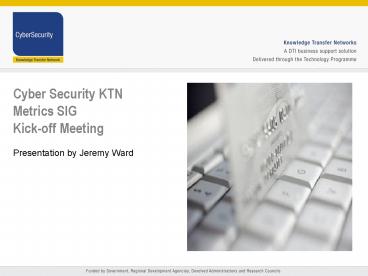Cyber Security KTN - PowerPoint PPT Presentation
1 / 12
Title:
Cyber Security KTN
Description:
about malicious code? ... Malicious code is a threat, but doesn't necessarily pose a risk; ... measurements look at malicious code and vulnerabilities, but ... – PowerPoint PPT presentation
Number of Views:29
Avg rating:3.0/5.0
Title: Cyber Security KTN
1
Cyber Security KTN Metrics SIG Kick-off
Meeting Presentation by Jeremy Ward
2
Todays Internet Threat Landscape
- Cybercrimes online fraud and the theft of
confidential information have some publicity. - But surveys (eg DTI breaches survey) show that
the impression is that Internet threats are less
significant as a result of decline in
well-publicised threats. - Quieter, stealthier threats now the norm, through
bots using customizable or modular malicious
code. - Web applications and web browsers increasingly
the focal point of attacks. - In countries with a longer history of on-line
trading (eg USA), there is evidence of
plateauing, or decline because trust is lost.
3
What does the Internet look like?
- Cybercrime is likely to increase
- as the rewards get more attractive, it is
logical that attackers will improve their
methods. - We believe that traditional perimeter defenses
are not enough - with the rise in client side attacks and web
application attacks, it seems likely that
attackers are able to find new ways into the
network. - We think that the volume and severity of attacks
continues to rise - because there is a short patch window,
increasing numbers of malicious code variants and
stealthy, silent attacks. - HOWEVER, WE DONT KNOW FOR SURE
4
We have some evidence
- Japanese Power Plant Compromised
- Database accessed with a hidden file sharing
program. Peer-to-Peer software allowed inside the
network. - European Bank Customers Compromised by Phishing
- Customers of large banks in the UK, Spain and
Germany have been infected with the sophisticated
Metafisher Trojan horse. - Text Files Compromised
- The Briz.A Trojan horse enabled a hacker to
obtain 62MB of text files (62,000 printed pages).
The hacker organised them into folders by
victims nationality and sold them to the highest
bidder. - These are good stories but theyre only
anecdotal!
5
What do we know objectivelyabout malicious code?
- Modular malicious code accounts for 88 of the
top 50 malicious code in a 6 month reporting
period
6
What do we know objectivelyabout threats to
confidentiality?
- Threats to confidential information continue to
increase with 80 of the Top 50 reported
malicious code having the potential to expose
confidential information.
7
What do we know objectively about
vulnerabilities?
- In the last 6 months of 2005, 69 of all
vulnerabilities reported to Symantec were web
application vulnerabilities.
8
The Challenges
- Malicious code is a threat, but doesnt
necessarily pose a risk - Vulnerabilities dont pose a risk unless there
are available exploits and they are unpatched - Current measurements look at malicious code and
vulnerabilities, but dont objectively assess the
risk they pose to ordinary Internet-connected
systems - No clear, objective, statistically valid way of
measuring the effectiveness of technological
countermeasures in ordinary Internet-connected
systems.
9
Proposal
- SIG should consider the design of a series of
testbeds to benchmark the reality of Internet
threats and the effectiveness of technological
countermeasures. - These should be representative of client systems
actually connected to the Internet. - Their build should be proportionate to market
representation in terms of OS, applications and
Web browsers. - They should be protected by a representative
selection of Firewalls and AV systems. - Each testbed should be monitored by IDS.
- All updated signatures and patches should be
applied.
10
Composition of Ordinary Systems Testbeds
OS Market Share
Browser Market Share
Data from Netapplications.com
11
Issues
- Statistically correct apportioning of
countermeasures to testbeds? - Number of testbeds needed?
- Maintenance of testbeds?
- Location of testbeds?
- Variability in delay of patching and updating?
- Can we do/do we need generation of false
traffic/Web browsing etc? - Design of analysis system for monitoring?
- Is this the right approach, or is there something
better?
12
Next Steps
- Volunteer to answer the questions on previous
slide! - Join the debate.
- Design the testbeds and the testing regime.































